|
Printables |
PowerPoints |
Online exercises |
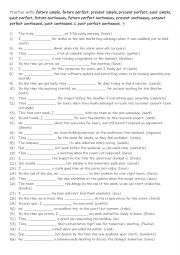
|
Practise with: future simple, future perfect, present simple, present perfect, past simple, past perfect, future continuous, future perfect continuous, present continuous, present perfect continuous, past continuous & past perfect continuous. 3
First, students need to familiarise themselves with the 12 tenses and their usage. Then they read the sentences to see which tense is needed to complete the sentence using the given infinitive in (). Answers on page 2.
Level: intermediate
Age: 10-100
Type:
Downloads: 124
|
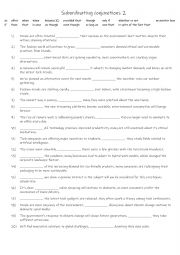
|
B1-C1 20 subordinating conjunctions 2
First, students need to familiarise themselves with the 20 subordinating conjunctions and their meanings. Then they read the sentences to see which one is needed to complete the sentence. Answers on page 2
Level: intermediate
Age: 10-100
Type:
Downloads: 124
|
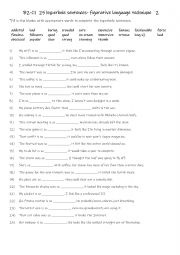
|
25 hyperbole sentences- figurative language technique 2
Learning hyperbole enhances creativity and helps students to express ideas vividly, making their writing more engaging and impactful. It improves communication skills by adding humour or emotional depth, while also fostering a better understanding of cultural and literary nuances. Recognising and using hyperbole sharpens analytical thinking, as stu...
Level: intermediate
Age: 12-100
Type:
Downloads: 124
|
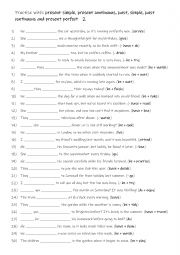
|
A2-B1 Practise with present simple, present continuous, past, simple, past continuous and present perfect 2
First, students need to familiarise themselves with the 5 tenses and their use. Then they read the sentences to see which one is needed to complete the sentence using the given infinitive in (). Each tense is used 6 times! Answers on page 2.
Level: elementary
Age: 9-100
Type:
Downloads: 124
|
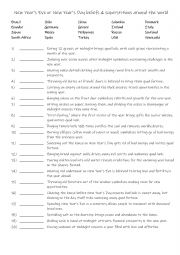
|
B1-C1 New Year�s Eve or New Year�s Day beliefs & superstitions around the world
First, students need to familiarise themselves with the 20 idioms and expressions and their meanings. Then they read the definitions to see which one is being described and write that word in the space provided Answers on page 2.
Level: intermediate
Age: 12-100
Type:
Downloads: 124
|
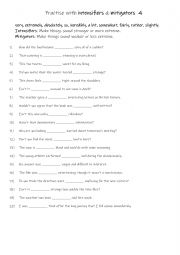
|
B1-B2 Practise with intensifiers & mitigators 4
First, students need to familiarise themselves with the intensifiers & mitigators and their use. Then they read the sentences to work out which one is needed to complete the gap-fill. Each intensifier & mitigator is used 2 times! Obviously, there are more than 1 possible answer! Possible answers on page 2
Level: intermediate
Age: 11-100
Type:
Downloads: 124
|
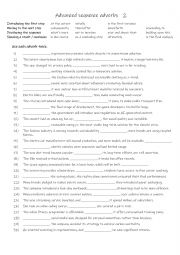
|
15 advanced sequencing adverbs 2
First, students need to familiarise themselves with the 15 adverbs and check their meaning and use. Then they read the sentences to see which adverb is needed to complete the sentence. Each adverb is used 2 times! Answers on page 2.
Level: intermediate
Age: 10-100
Type:
Downloads: 124
|
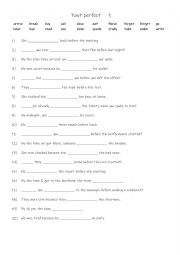
|
Past perfect 1
First, students need to familiarise themselves with the 20 verbs. Then they read the sentences to see which verb is needed to complete the sentence. Each verb is used 1 time! Answers on page 2
Level: intermediate
Age: 8-100
Type:
Downloads: 124
|
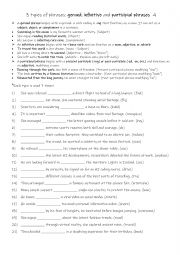
|
B1+-C1 3 types of phrases gerund, infinitive and participial phrases 4
First, students need to familiarise themselves with the 3 types of phrases and their use. Then they read the sentences to work out which one is needed to complete the gap-fill. Each verb pattern is used 7 times! Answers on page 2.
Level: intermediate
Age: 11-100
Type:
Downloads: 124
|
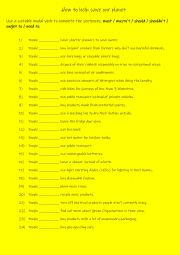
|
Ways to help save our planet
A gap-fill activity using various modal verbs. After completing the sheet, students can either do pair / group work to expand the topic by giving reasons , benefits , downside of doing each of the 24 activities.
Level: elementary
Age: 10-100
Type:
Downloads: 123
|
|
|
|
|












